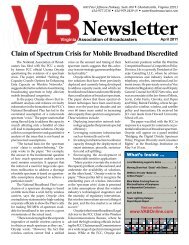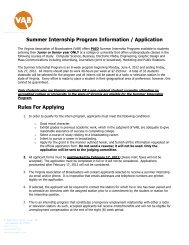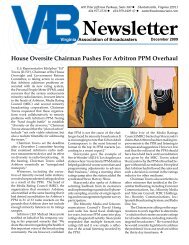Newsletter
Download - Virginia Association of Broadcasters
Download - Virginia Association of Broadcasters
Create successful ePaper yourself
Turn your PDF publications into a flip-book with our unique Google optimized e-Paper software.
VAB NEWSLETTER OCTOBER 2009VA White Spaces Broadband NetworkVAB <strong>Newsletter</strong>Published monthly by the Virginia Association ofBroadcasters600 Peter Jefferson Parkway, Suite 300Charlottesville, VA 22911434.977.3716 (p); 434.979.2439 (f)www.vabonline.comPRESIDENTPAST PRESIDENTPRESIDENT-ELECTSECRETARY/TREASUREREXECUTIVE DIRECTORDoug DavisWAVY-TV, PortsmouthMichael GuldWBBT-FM, RichmondFrancis WoodWFLO-AM/FM, FarmvilleWarren FiihrWSLS-TV, RoanokeDouglas EasterASSOCIATE ADVISORYHarrison PittmanOn-Time Online Broadcast Compliance, Newport NewsBOARD MEMBERSDistricts 1 & 2Charlie (Charles) Russell WESR-AM/FM, OnleyLarry SaundersWGH-AM/FM/WVBW-FM/WXMM-FM/WXEZ-FM, Virginia BeachBob PetersonLinda ForemBob WilloughbyDennis Royer, Sr.Leonard WheelerJack DempseyTheresa KellerRandy SmithDennis MocklerDoris NewcombRobert ScutariDistrict 3WRIC-TV, RichmondWCDX-FM/WKJM-FM/WKJS-FM/WPZZ-FM/WTPS-AM, RichmondWKHK-FM/WMXB-FM/WKLR-FM/WDYL-FM, RichmondDistricts 4 & 5WBBC-FM/WKLV-AM, BlackstoneDistricts 6 & 9WFIR-AM/WSLC-FM/WSLQ-FM/WVBE-AM/FM/WXLK-FM, RoanokeWJHL-TV, Johnson City, TNWEHC-FM, EmoryWSET-TV, LynchburgDistricts 7, 8 & 10WCHV/WCYK/WHTE/WKAV/WWTJ/WZGN, CharlottesvilleWFAX-AM, Falls ChurchWJLA-TV, ArlingtonCONSULTANTSLabor Law Employment CounselJohn G. Kruchko, Paul M. LuskyKruchko & Fries1750 Tysons Boulevard, Suite 560McLean, VA 22102(703) 734-0554The first public white spacesnetwork has launched in Claudville,Virginia. It is uses sensing technologyfrom Spectrum Bridge with softwareand Web cams supplied by Microsoftand PCs supplied by Dell.During a press conference announcingthe white-spaces network, U.S. Rep.Rick Boucher (D-Va.), chairman of theHouse subcommittee on communications,technology and the Internet, calledthe deployment a “milestone” in ruralbroadband deployment.“It is our hope that this will demonstratedefinitely that white spaces canwork,” Boucher said.White spaces are services that runin the unused portion of televisionspectrum, and have been called “WiFion steroids” by Google founder LarryPage. The battle for white spaces hasbeen going on for years. IT companieslike Microsoft, Dell and Google lobbiedin favor of opening up the spectrum fordata services, particularly broadbandInternet access, while those in the broadcastingindustry vehemently opposedthe idea.In February, the National Associationof Broadcasters and Association forMaximum Service Television (MSTV)filed a lawsuit against the Federal CommunicationsCommission over its decisionto authorize unlicensed devices forsending and receiving broadband overunused television channels.“As several engineering tests haveshown, portable, unlicensed personaldevice operation in the same band as TVbroadcasting continues to be a guaranteedrecipe for producing interference,”said NAB Media Relations director KrisJones.Broadcast engineers, includingCharles Rhodes, who ran the technicalarm of the Advanced Television TestingLab, noted that digital TV signalsrequired a buffer zone (à la taboo channels)as much as did analog signals.Digital reception was--and still is--beingFirst Amendment HotlineCraig T. MerrittChristian, Barton, Epps,Brent & Chappell1200 Mutual BuildingRichmond, VA 23219(804) 697-4100worked out.Almost a year ago, in November,2008, the FCC voted to allow carriersand other vendors to deploy devices inthe unlicensed white spaces spectrumat up to 100 milliwats, and up to 40 milliwatson white space spectrum adjacentto TV channels. However white spaceswill support bigger bandwidth for fasterdownloads over longer distances thanWiFi. It also is less prone to interferencefrom walls and other obstacles.One condition the FCC placed onwould-be white spaces providers at thetime is that the devices would need sensingcapabilities that would automaticallyshut them down should they interferewith television. Devices were also to haveaccess to a geo-location database to trackthem by their IP address or media-access-controladdress or a radio-frequencyidentification tag. Once the database hada fix on the device’s location, it was tobe able to select the optimal white-spacespectrum for the device and switch thespectrum as the device moves.Spectrum Bridge provided thedatabase that ensures the white spacesdevices in Claudville do not cause interferencewith local TV signals. “The databaseassigns non-interfering frequenciesto white spaces devices, and can adaptin real time to new TV broadcasts, aswell as to other protected TV band usersoperating in the area,” the companyexplains.Tests of those early devices by theFCC were said to show that they didindeed cause the feared interference withtelevision signals, though Microsoft saidthat the device tested must have beendefective. A second round of tests on anew Microsoft prototype device apparentlydidn’t have the same problems.ESPN, the Broadway League of NewYork (an association for the theaterindustry),and other entities that use wirelessmicrophones also filed a lawsuit tochallengethe “white spaces” rules in theSecond Circuit Court of Appeals. vFCC/EEOC MattersWade Hargrove, Mark J. Prak,Marcus Trathen, Coe RamseyBrooks, Pierce, McLendon,Humphrey & Leonard, L.L.P.P.O. Box 1800Raleigh, NC 27602(919) 839-0300; Fax: (919) 839-0304








